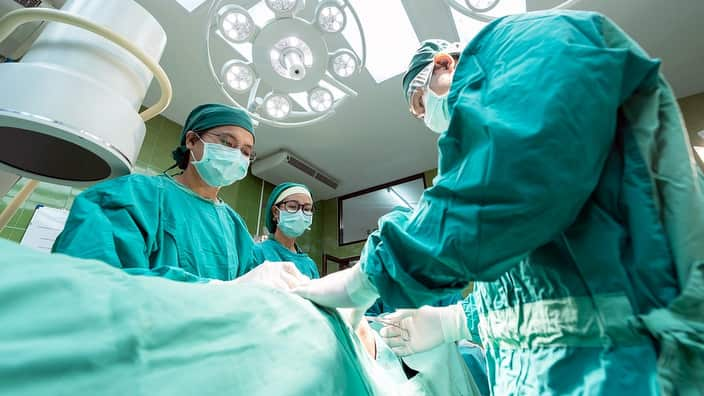ਅਮਾਯਾ ਬੇਦੀ ਨੂੰ ਅੱਖਾਂ ਦੀ ਉਹ ਭਿਆਨਕ ਜੈਨੇਟਿਕ ਬਿਮਾਰੀ ਹੈ ਜੋ ਇੱਕ ਲੱਖ ਅਬਾਦੀ ਵਿਚੋਂ ਇੱਕ ਵਿਅਕਤੀ ਨੂੰ ਹੁੰਦੀ ਹੈ।
ਚਾਰ-ਸਾਲਾ ਅਮਾਯਾ ਨੂੰ ਲੇਬਰ ਕੋਨਜਿਨੀਟਲ ਅਮੌਰੋਸਿਸ ਹੈ ਜਿਸਦੇ ਚਲਦਿਆਂ ਆਮ ਤੌਰ ਤੇ ਅੱਖਾਂ ਦੀ ਰੋਸ਼ਨੀ ਘਟਦੀ-ਘਟਦੀ ਹਮੇਸ਼ਾ ਲਈ ਖਤਮ ਹੋ ਜਾਂਦੀ ਹੈ।
ਅਮਾਯਾ ਦੇ ਪਿਤਾ ਗਗਨਦੀਪ ਸਿੰਘ ਬੇਦੀ ਨੇ ਐਸ ਬੀ ਐਸ ਪੰਜਾਬੀ ਨੂੰ ਦੱਸਿਆ ਕਿ ਇੱਕ ਮਹਿੰਗੀ ਪ੍ਰਯੋਗੀ ਜੀਨ ਥੈਰੇਪੀ ਲਈ ਉਹਨਾਂ ਦਾ ਪਰਿਵਾਰ ਅਮਰੀਕਾ ਦੇ ਫਿਲਾਡੈਲਫੀਆ ਸ਼ਹਿਰ ਜਾਣ ਦੀ ਸੋਚ ਰਿਹਾ ਹੈ।
"ਸਾਨੂੰ ਇਹ ਪਤਾ ਲੱਗਿਆ ਹੈ ਕਿ ਅਮਰੀਕਾ ਵਿੱਚ ਐਲ ਸੀ ਏ ਬਿਮਾਰੀ ਨਾ ਸਬੰਧਿਤ ਕੁਝ ਇਲਾਜ ਹੋਏ ਹਨ। ਪਰ ਸਾਡੇ ਲਈ ਇਹ ਜਾਣ ਲੈਣਾ ਜਰੂਰੀ ਸੀ ਕਿ ਐਲ ਸੀ ਏ ਵੀ ਕਈ ਪ੍ਰਕਾਰ ਦੀ ਹੈ। ਸੋ ਸਾਨੂੰ ਓਥੇ ਜਾਕੇ ਅਮਾਯਾ ਨੂੰ ਚੈੱਕ ਕਰਾਉਣਾ ਪੈਣਾ ਕਿ ਕੀ ਉਹ ਇਸ ਇਲਾਜ ਦੇ ਯੋਗ ਵੀ ਹੈ।
"ਅਗਰ ਇਸ ਤਰਾਹ ਹੋ ਜਾਂਦਾ ਹੈ ਤਾਂ ਅਮਾਯਾ ਕਲੀਨੀਕਲ ਟਰਾਇਲ ਦਾ ਹਿੱਸਾ ਬਣ ਸਕੇਗੀ - ਆਮ ਤੌਰ ਤੇ ਇਹੋ ਜਿਹੇ ਇਲਾਜ ਦਾ ਖਰਚਾ ਇੱਕ ਮਿਲੀਅਨ ਡਾਲਰ ਤੱਕ ਪਹੁੰਚ ਜਾਂਦਾ ਹੈ।"
ਬੇਦੀ ਪਰਿਵਾਰ ਹੁਣ ਇਸ ਬਿਮਾਰੀ ਖਿਲਾਫ ਜਨ-ਚੇਤਨਾ ਦੀ ਮੁਹਿੰਮ ਛੇੜਨਾ ਚਾਹੁੰਦਾ ਹੈ। ਉਹ ਚਾਹੁੰਦੇ ਹਨ ਕਿ ਆਸਟ੍ਰੇਲੀਆ ਵਿੱਚ ਇਹੋ ਜਿਹੀਆਂ ਬਿਮਾਰੀਆਂ ਦੇ ਇਲਾਜ ਲਈ ਸਇੰਸ ਦੀ ਹੋਰ ਖੋਜ-ਕੀਤੀ ਜਾਵੇ ਤਾਂਕਿ ਇਸ ਬਿਮਾਰੀ ਦਾ ਇਲਾਜ ਲੱਭਿਆ ਜਾ ਸਕੇ।
Read this story in English
Amaaya Bedi suffers from a rare genetic eye disease that is estimated to affect around 1 in 100,000 people.
The four-year-old has inherited Leber Congenital Amaurosis (LCA) - a rare retinal disease that causes severe visual impairment in infancy or early childhood.
Children born with LCA have poor vision because of the impaired development of the retina which is the light sensitive film at the back of the eye.
The extent of vision loss varies from person to person, but can be quite severe as it is in the case of little Amaaya.
The Singh family’s only hope now rests on a costly experimental gene therapy available in the US city of Philadelphia.
Amaaya’s father, Gagandeep Singh Bedi, told SBS Punjabi that he is very concerned over the treatment options.
“The disease is so rare that there is little research to offer any successful breakthroughs. There is only one hope and that is with a hefty gene therapy treatment available at an experimental level in Philadelphia,” he says.
“We are also aware that some patients were given treatments for another form of LCA that costed them $850,000 for both eyes.
“Amaaya's LCA is due to CRB1 gene. Once we go to USA then only we’ll be able to find out if they can enrol her in any upcoming clinical trials.  The Singh family moved to Australia from New Delhi in 2008. They’ve been researching treatment options ever since Amaaya was born four years ago.
The Singh family moved to Australia from New Delhi in 2008. They’ve been researching treatment options ever since Amaaya was born four years ago.

Source: Pixabay
“We’ve made contact with more than 40 ophthalmologists in Australia and overseas. The experts are very kind to listen to our story but there is little success on the treatment front,” said Mr Singh.
“It is always a problem where patients suffer from rare diseases. The disorders are often so uncommon that a GP [general practitioner] may have never seen a patient with the disease, and may be unable to provide treatment options or support. Therefore, the burden of understanding the disease, finding resources and help falls on the family.
He says his family wants to raise awareness as little is known about this rare condition.
“If we find more patients we can push for a need for more research. We need more research and treatment facilities that could eventually offer hope to people with a form of this disease.
“Australia has one of the best medical facilities in the world. We really need trials and treatments available in our country not only for our only daughter but also for any other children suffering from rare genetic disorders.
Share



